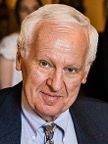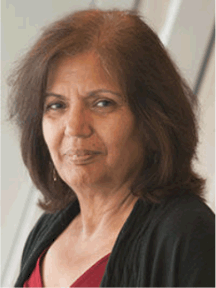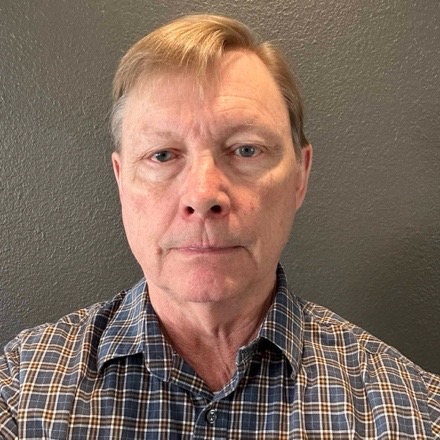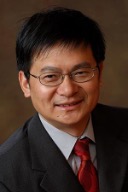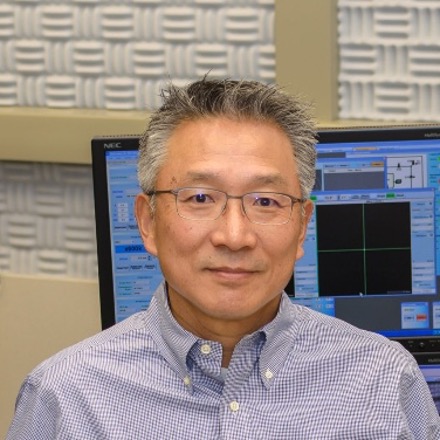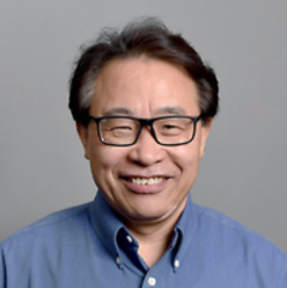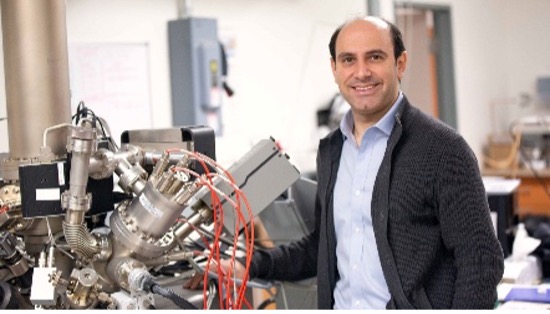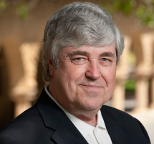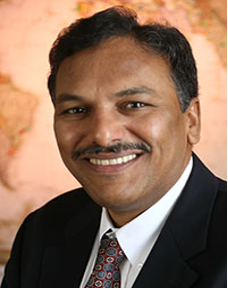Electron Microscopy blooming in the desert: the beginnings of the Eyring Materials Center
Ondrej L. Krivanek, FRS
Senior Scientific Advisor in the Electron Microscopy Unit of Bruker AXS, and an Affiliate Professor at Arizona State University.
Combining three things - fertile soil, winter rains, and the right kinds of established plants and ambitious new seeds - creates beautiful blooms in the Arizona desert every spring. The blooming of electron microscopy at ASU followed a similar path, with the Eyring Materials Center furnishing the fertile soil, NSF and other agencies sending us infrequent but essential funding rains, and established scientists as well as talented new seeds sprouting remarkable blooms. The blooms gave rise to new seeds and rich harvests in many other places where they were planted. My brief talk will review some of the early blooms ASU cultivated in the 1970s and 80s, and place them in the wider context of other developments that transformed electron microscopy.
|
|
Bio Ondrej is a co-founder and ex-president of Nion Co., a maker of advanced electron microscopes, which was recently acquired by Bruker. He is well known for developing several new instruments that have endowed electron microscopes with revolutionary new capabilities, such as electron energy loss spectrometers and imaging filters, aberration correctors, advanced monochromators, and whole electron microscopes. Examples of research made possible by these instruments include imaging and analyzing the bonding properties of single atom impurities in materials, and opening up the field of vibrational spectroscopy in the electron microscope, with very high spatial resolution. His work has been honored by several prizes and honorary fellowships and doctorates, including an election to the UK Royal Society, and the 2020 Kavli Prize for Nanoscience.
|
LeRoy Eyring: A Visionary
Renu Sharma,
Emeritus Fellow, National Institute of Standards and Technology, Emeritus, Arizona State University
LeRoy Eyring joined ASU as the chair of Chemistry department after having worked at various academic institutions in Europe and Australia. The international experience probably helped him to envision a future for collaborative research across different disciplines and institutes that lead him to seek funding to establish Center for Solid State Science which evolved into the current Eyring Materials Center. His research was centered around the structures of rare earth oxides, e.g. cerium, praseodymium, terbium oxide. Ordered oxygen vacancies in these oxides results in materials with complicated structures with large unit cell that were difficult to solve with traditional x-ray diffraction technique. This led him to include TEM as one of characterization technique in the shared facility: Center for Solid State Science. He was also instrumental in bringing Prof. Cowley, under whose supervision National Center for transmission electron microscopy was established with the help of a grant from NSF. His research group utilized TEM based techniques not only to decipher the oxides with long range ordered vacancies but also to understand their formation mechanism using ‘in situ’ electron beam heating. He also realized that electron beam is not ideal for controlled experiments and travelled to NCEM to utilize their environmental cell TEM (Kratos). I joined his group in 1985 to perform such in situ observations and develop environmental TEM for controlled heating experiments in gaseous environment. I will present some examples spanning from the early days of electron beam heating to the controlled experiments and their contribution to our understanding of oxide chemistry.
|
|
Bio Renu Sharma is one of the pioneers in the development of environmental scanning transmission electron microscopy (E(S)TEM). She received a B.S. and B.Ed. in Physics and Chemistry from Panjab University, India, and M.S. and Ph.D. degrees in Solid State Chemistry from the University of Stockholm, Sweden, where she had a Swedish Institute Fellowship. Renu joined National Institute of Standards and Technology (NIST) as a project Leader in 2009, coming from Arizona State University (ASU), where she modified two TEM columns to function as an ETEM. AT ASU, she was a research scientist in the Department of Chemistry and Biochemistry, the Center for Solid State Science, and an affiliated faculty member in the School of Materials and Department of Chemical Engineering. She has written one book on in situ TEM and is lecturer at the Arizona State University Winter School. Renu is a Fellow of Microscopy Society of America, has received a Bronze Medal of Service from US Department of Commerce for developing new measurement techniques, a Deutscher Akademischer Austauschdienst (DAAD) Faculty Research Fellowship, is past President of the Arizona Imaging and Microanalysis Society. At NIST, Renu established advanced E(S)TEM measurement capabilities, that combine Raman and cathodoluminescence spectroscopies with electron diffraction, electron spectroscopy and high-resolution imaging (ETEM Lab). She is now an Emeritus NIST Fellow and Emeritus scientist at ASU
|
Experiences of a Research Scientist in the
Eyring Materials Center/CSSS during the 1980s and 1990s.
Richard L. Hervig, Professor
School of Earth & Space Exploration
Arizona State University
Peter Williams (Prof in Chemistry) and colleagues were awarded funds to purchase a secondary ion mass spectrometer in the 1980s. Because of Pete’s interest in collaborative research, he wanted to open his lab to many scientists. Because of my familarity in this field I was hired in the Center in the late 1980s to provide access to this complex instrument. I will describe the results of that decision, in terms of the collaborative interdisciplinary research, teaching/training of students, multiple services to the community, and recognition of ASU as a leader in this technique.
|
|
Bio Richard (Rick) Hervig received his BS in 1975 from the University of Iowa (Geology) and his Ph.D from the University of Chicago (Geophysical Sciences) in 1979. He worked in nuclear waste disposal at what is now Pacific Northwest National Lab before taking a position with Alex Navrotsky at ASU in 1981, where he studied the thermodynamic properties of glasses and minerals. He was hired in the predecessor to the Eyring Materials Center (Center for Solid State Science) as an Asst. Research Scientist in 1987, and left this Center in 2004 to take a position as Professor in the Department of Geological Sciences (now the School of Earth & Space Exploration). Hervig has developed new analytical techniques in secondary ion mass spectrometry (SIMS) and has made significant improvements in instrument performance through implementation of novel designs. He has contributed 6 chapters to Reviews in Mineralogy and Geochemistry volumes concerning the applications of SIMS to Geochemical and Cosmochemical problems. Hervig’s collaborative research with electrical engineers has presented new ways of applying SIMS to problems in earth science. Besides training researchers in the use of SIMS, he also teaches classes in petrology, geochemistry, nuclear forensics, science communication, and analytical instrumentation to chemistry, engineering, and geology students. |
From electron nanodiffraction to 4D-STEM: EMC’s contributions to materials science
Jian-Min Zuo
Dept of Materials Science and Engineering, and Materials Research Laboratory, University of Illinois Urbana-Champaign, IL 6801, USA
The recent developments in electron optics and fast detectors have revolutionized the way materials are characterized at atomic and nm scale. Through the collection of massive diffraction datasets and by data-mining the hyperspectral datasets, the materials atomic, electronic and magnetic structure can be characterized in a quantitative way, and yet at unprecedented resolution and details. This form of data-driven electron microscopy is fundamentally different from traditional imaging approaches that were based on lenses and apertures [1]. This talk will showcase the advances in data-driven electron microscopy and highlight Eyring Materials Center (EMC) contributions in pioneering scanning transmission electron microscopy (STEM), electron nanodiffraction and quantitative convergent-beam electron diffraction – the components in four-dimensional (4D) STEM. It will be shown the essential role of centralized facility, academic curiosity and collaborations in advancing modern materials science.
References:
[1] J. M. Zuo et al., Microscopy 71, i116 (2022).
|
|
Bio Jian-Min Zuo is the Ivan Racheff Professor of Materials Science and Engineering at the University of Illinois, Urbana-Champaign. He received his Ph.D. in Physics from Arizona State University (ASU) in 1989. At University of Illinois, he and his research group pioneered the atomistic structure study of nanostructured materials, ultrafast electron diffraction, interfaces and chemical bonding, through the development of coherent electron nanodiffraction, aberration-corrected electron imaging and scanning electron nanodiffraction techniques. Prof. Zuo is a fellow of American Physical Society and Microscopy Society of America, a recipient of Ernst Ruska Prize of the German Society for Electron Microscopy and Gjonnes Award from International Union of Crystallography. He is the author, with Prof. John CH Spence of ASU, of the 2017 book, Advanced Transmission Electron Microscopy: Imaging and Diffraction in Nanoscience, published by Springer. |
Discovery of New Nanomaterial Phases and NanoArt
Moon J. Kim
Department of Materials Science and Engineering
The University of Texas at Dallas
With the advancement of technology and computational methods in the era of the materials genome, the exploration of new and emerging materials for potential applications has accelerated. The use of non-conventional processes and non-equilibrium conditions in material fabrication and processing presents unique opportunities to discover novel material phases beyond the predictions of traditional phase diagrams and theoretical models. In particular, atomic-resolution electron microscopy, combined with in-situ capabilities, serves as a powerful tool for uncovering these new phases.
In this presentation, I will discuss two recently discovered material phases:
- Mo₆Te₆ nanowire
- Two-dimensional tellurium (Tellurene)
Additionally, I will introduce NanoArt, an emerging discipline that highlights the artistic beauty of natural and engineered nanometer-scale materials. I will showcase a selection of my NanoArt collections, including AI-stylized pieces and the NanoArt-In-Motion series, which blends the visual elegance of NanoArt with the fluidity of choreographed dance.
|
|
Bio Dr. Moon Kim’s research and technical expertise focus on nanofabrication and the manipulation and characterization of materials and devices for electronic and photonic applications. His expertise includes high-resolution electron microscopy, wafer bonding technology and 3D functional nanostructures and nanodevices. As an expert in nanotechnology in the 1990s, Kim became one of the first researchers in the world to build an ultra-high vacuum wafer bonding instrument. That machine, now housed in the Natural Science and Engineering Research Laboratory, was a cornerstone to enabling groundbreaking research in the region, international collaborations and the attainment of more advanced equipment and world class professors. |
In Search of Catalytically Active Centers of Solid Catalysts
Jingyue (Jimmy) Liu
Arizona State University
Catalysis is used to produce a broad range of products, including fuels, plastics, pharmaceuticals, chemicals/agrichemicals, and other functional materials. To achieve a future of a renewable, circular, and sustainable society, it is imperative to understand the intrinsic nature of active sites in heterogeneous catalysis and construct the most desirable active sites for chemical transformations of molecules. The essential role of solid catalysts is to efficiently facilitate the targeted molecular reactions, reduce toxic/waste side products, and lower production costs. Figuring out precisely where the active sites on a practical solid catalyst has been a formidable challenge since the idea that only specific sites on a catalyst surface are responsible for reactions was introduced by Taylor in 1925. The aberration-corrected scanning transmission electron microscope (ac-STEM) is one of the most powerful tools for identifying the nature of active centers of solid catalysts and for optimizing catalyst synthesis processes. The discovery and development of single-atom catalysis was primarily driven by the capabilities of ac-STEMs, allowing direct visualization and analysis of isolated metal atoms on a support material and their structural relationship to the neighboring atoms of the support surface. With the growing understanding of the unique catalytic properties of isolated metal atoms (active sites), particularly their strong interactions with the support atoms (ligands), and the rapid advances of scalable synthesis methods to produce single-atom catalysts (SACs), we have been witnessing the rapid progress of understanding catalytically active centers of solids and the development of highly efficient and practical SACs for energy, environment, and sustainability. Controlling the hybridization of different metal atoms (e.g., heteroatom dimers and alloy clusters) in desirable host materials opens vast opportunities for designing and developing atomically dispersed catalysts, enabling heterogeneous catalysis at the single-atom limit.
|
|
Bio Jingyue Liu received his bachelor's degree in metal physics from the University of Science and Technology Beijing, China, and his PhD in condensed matter physics from Arizona State University under the guidance of Professor John M. Cowley. He was a postdoctoral research associate and research scientist in the LeRoy-Eyring Center for Solid State Science of ASU before he joined Monsanto Corporate Research as a research specialist and group leader in 1994. After a series of promotions, he was appointed as a Science Fellow of Monsanto in 2000 and a Senior Science Fellow in 2003 for sustained outstanding technical leadership and significant impacts on Monsanto's businesses. He received the prestigious 2001 Edgar M. Queeny Award for Science and Technology, the highest award within Monsanto for scientific achievement and business impact. In 2006, he joined the University of Missouri-St. Louis as the director of the Center for Molecular Electronics and Professor of Physics and Chemistry, and in 2007 became the founding director of the Center for Nanoscience. He joined Arizona State University in 2011 as professor of physics. He became a Fellow of the Microscopy Society of America in 2012. |
Advancing Atomically Thin Quantum Materials with EMC’s Unparalleled Metrology Capabilities
Seth Ariel Tongay
ASU
Over the past five decades, EMC at ASU has played a pivotal role in enabling groundbreaking research on atomically thin quantum materials. These materials, which hold immense promise for next-generation electronics, quantum devices, and advanced manufacturing, present significant challenges in characterization due to their extreme thinness and sensitivity. However, thanks to EMC’s world-class capabilities and expert staff, metrology on these technically challenging materials has been made not only feasible but highly effective. In this talk, we will survey key innovations made possible through EMC’s advanced characterization techniques. One of the most exciting breakthroughs involves the integration of 2D materials into diamond anvil cells, allowing us to push the boundaries of these materials under extreme high-pressure conditions. This research sheds light on phase transitions, electronic structure modifications, and novel quantum phenomena that emerge under extreme environments. Additionally, we will discuss how even fundamental tasks, such as TEM sample preparation for 2D materials, once considered formidable, have been revolutionized by EMC’s technical expertise/ Through precise sample handling and imaging advancements, we have gained atomic-scale insights into defects and imperfections, providing invaluable data to refine 2D material synthesis and integration strategies. By leveraging EMC’s cutting-edge metrology capabilities, we have pushed the frontiers of 2D material manufacturing, enabling new possibilities for defect engineering, heterostructure fabrication, and scalable quantum material integration. This presentation will highlight how EMC’s sustained support and technological excellence have been instrumental in overcoming longstanding challenges, ultimately accelerating innovation in the field of atomically thin materials.
|
|
Bio Prof. Dr. Seth Ariel Tongay is a renowned materials scientist specializing in materials deposition and characterization. He is an expert in EPI deposition, 2D material synthesis, and characterization to realize 2D single crystal layers and next-generation 2D semiconductors. Prof. Tongay published over 300 journal articles and holds several patents in epitaxy domain. He has been recognized as a Highly Cited Researcher by Web of Science for six consecutive years (2019-2024). He has been recognized as APS Fellow, Fellow of Royal Society of Chemistry (UK). He received the Presidential Early Career Award, Ten Outstanding Young Persons Award, the NSF Career Award, among other international accolades. He boasts an h-index of 83 with over 30,000 citations. |
Is TEM/STEM still useful as a Microscope: a case study of “twisted epitaxy”?
Robert Sinclair, Yi Cui, Pawel Czaja and Yi Cui
Department of Materials Science and Engineering, Stanford University, Stanford, CA 94305-
4034, United States of America.
Since the foundational work of Cowley and Iijima, Buseck and Eyring, and many others in the 1970’s, high resolution electron microscopy has become the essential method for directly observing the atomic arrangements in materials and devices. However, the TEM and STEM environments provide a mini laboratory for all kinds of experiments, be they physical, chemical, biological, electrochemical etc. With the remarkable advances in such applications in parallel with inexorable development of imaging, analytical and indeed computational capabilities, it could be asked whether TEM is still useful as a “microscope” itself. This suggestion is emphatically put to rest by the example of the recent discovery of “twisted epitaxy” in metal-2D material intergrowths [1], which will be described in this presentation.
[1] “Twisted epitaxy of gold nanodisks grown between twisted substrate layers of molybdenum disulfide.”Y. Cui, J. Wang, Y. Li, Y. Wu, E. Been, Z. Zhang, J. Zhou, W. Zhang, H.Y. Hwang, R. Sinclair and Y. Cui. Science, 383(6679), pp.212-219 (2024).
|
|
Bio Robert (Bob) Sinclair is the Charles M. Pigott Professor in the School of Engineering at Stanford University. He received his degrees in Materials Science from Cambridge University; and following a postdoctoral position at the University of California, Berkeley he joined the faculty in the Department of Materials Science and Engineering at Stanford in 1977. His group’s research has focused on the application of advanced transmission electron microscopy (TEM) techniques, especially at high resolution, to addressing important issues in materials science, especially in the semiconductor and magnetics areas, and in medical nanotechnology. The work on in situ high-resolution TEM and interface reactions is likely the most well-known. He was Department Chair from 2004-2014 and Director of the Stanford Nanocharacterization Laboratory for twelve years since its founding in 2002. His group’s work has been recognized by the Distinguished Scientist Award (Physical Sciences) of the Microscopy Society of America in 2009 and the David M. Turnbull Award of the Materials Research Society in 2012. |
Towards the Renaissance Era in Electron Microscopy:
From Soft & In-Situ Microscopy to High Throughput & AI-enabled Discovery
Vinayak P. Dravid
Department of Materials Science & Engineering,
Founding Director, NUANCE Center & SHyNE Resource (An NSF-NNCI Node)
Northwestern University; Evanston, IL 60208, USA
Characterization by scanning transmission and transmission electron microscopy (S/TEM) is often criticized as subjective, slow and less amenable to automation. These considerations are further exacerbated under in-situ or operando conditions which pose additional challenges of consistency, reproducibility with localized constraints and incompatibility with the “round-robin” approach. The ongoing work in our group is meant to dispel these notions. Our approach is inspired by innovations in high-throughput assays and related automation in biotech and bioinformatics.
We combine novel design and nanofabricated specimen stages with smart data acquisition strategies. It is tailored to “ration” both electrons and time, spatially and temporally, utilizing AI/ML approach and methods.
The presentation will cover emerging opportunities in advanced microscopy. It will cover innovative nanofabricated ultra-thin (UT) window fluidic cells for nanoscale discrimination of reactants and products in catalysis. The presentation will explore the feasibility of AI/ML-enabled data acquisition for rapid and high throughput materials discovery, as well as monitoring of in-situ phenomena in the temporal domain.
The local and extended ASU microscopy community has played indispensable role advancing electron microscopy across the globe for decades. I will share some historical examples and make the case for the upcoming Renaissance era in electron microscopy!
|
|
Bio Vinayak P. Dravid is the Abraham Harris Professor of MSE at Northwestern University. He is the founding Director of the NUANCE Center and SHyNE Resource (NSF-NNCI Center). His scholarly interests revolve around nanoscale solutions to gigaton challenges of energy and environment, utilizing microscopy and characterization methods. One of Vinayak’s passions is to enhance societal and global appreciation for science and technology, through the lens of microscopy and nanotechnology. |


